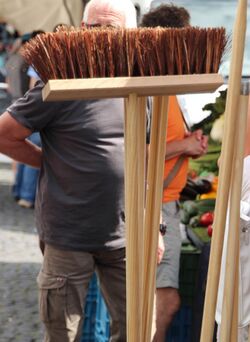Biology:Piassava
From HandWiki
Short description: Fibrous product of Brazilian palm species Attalea funifera and Leopoldinia piassaba
Piassava, also piaçava (Portuguese pronunciation: [pi.(j)ɐˈsavɐ]), piaçaba ([pi.(j)ɐˈsabɐ]), piasaba, pissaba, piassaba, and piaçá ([pjɐˈsa]),[1] is a fibrous product of Brazil ian palm species Attalea funifera and Leopoldinia piassaba. It is often used in making brooms and for other purposes.[citation needed]
Piassava was historically exported to Europe before the widespread use of synthetic materials such as plastic. Today, it is mostly used locally in South America.[2]
See also
- West African piassava palm
References
- ↑ The piaçá form occurs mostly in Portugal and is considered less correct by some dictionaries.
- ↑ Brokamp, Grischa (2015). Relevance and Sustainability of Wild Plant Collection in NW South America: Insights from the Plant Families Arecaceae and Krameriaceae. Wiesbaden: Springer Spektrum. doi:10.1007/978-3-658-08696-1. ISBN 978-3-658-08695-4. https://www.springer.com/gp/book/9783658086954.
- Exploration of the Valley of the Amazon Vol. I by Lieutenant William Lewis Herndon (1853) chapter 14, p. 285
- Webster's Revised Unabridged Dictionary (1913)
 |


